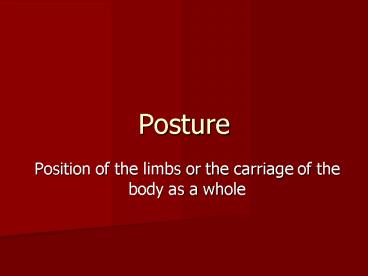Posture PowerPoint PPT Presentation
1 / 9
Title: Posture
1
Posture
- Position of the limbs or the carriage of the body
as a whole
2
Posture
- Posture is defined as "the position or bearing of
the body" (Websters Medical Dictionary ) and
refers to the overall alignment of the various
body parts to each other when the person is
standing in a relaxed stance. - Posture is the result of many underlying
processes and tensional relationships throughout
the body. - As such posture becomes a measure of the overall
balances in the body and can be used as a tool to
assess if interventions have resulted in a change
in overall body balance.
3
Optimal Posture vs. Faulty Posture
- Optimal posture
- State of muscular and skeletal balance that
protects the supporting structures of the body
against injury or progressive deformity - Involves the positioning of the joints to provide
minimum stress on the joints of the body. - Faulty Posture
- Increases stress on the joints.
4
Ideal Posture
- The ideal posture is assumed to be when the
earlobe, tip of the shoulder, hip joint and
outside bump (malleolus) of the ankle all lined
up on a plumb line. - Variations from this ideal give the therapist
clues as to areas of the body that do not permit
the full mechanical ability for which they are
designed.
5
Poor Posture
- One of the first indicators of poor posture is a
slouching or forward head posture. - This posture closes down on lymphatic drainage in
the neck and will cause more strain on the
posterior neck muscles. - It also increases the weight bearing on the discs
and can lead to premature arthritis of the neck. - There are many causes of this type of posture
including car accidents, sports injuries, working
with computers and loss of bone density.
6
Causes of Poor posture
- Structural Causes
- Permanent anatomical deformities not amenable to
correction by conservative treatments - Positional Causes
- Poor postural habit--for whatever reason, the
individual does not maintain a correct posture - Psychological factors, especially self-esteem.
- Respiratory conditions
- General weakness
- Loss of the ability to perceive the position of
your body
7
Tests for Postural Faults
- The Mirror Test- (Anterior View)
- Stand facing as full length mirror and check to
see if - your shoulders are level
- your head is straight no chin deviation ears
are level - the spaces between your arms and sides are
equally spaced - your iliac crests and hips are level
- kneecaps face straight ahead
- a 5 foot flare is shown
- arches are not flat
- no evidence of scrunching of the toes
8
Correcting Poor Posture
- There are many therapies or treatments on how to
treat posture and the alignment of the body
parts, some of them are - Alexander Technique
- CranioSacral Therapy
- Physical Therapy
- Tai Chi
- Yoga
- Osteopathy
- Feldenkrais Method
- Chiropractic
- Rolfing
- Somatics
- All of them try to find the way in which good
posture is achieved with the less effort applied.
9
Orthotics and Posture
- Orthotic devices are employed to correct and
support posture. - An orthosis is an external appliance worn to
restrict or assist motion or to transfer the load
from one area to another. - Adjustments allow all joints to function under a
proportionate weight distribution.

